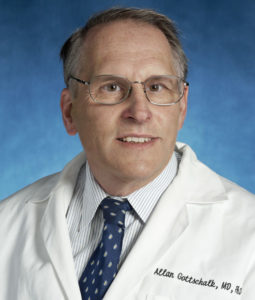Allan Gottschalk
 Dr. ALLAN GOTTSCHALK is a second generation anesthesiologist who was raised on Long Island. With an anesthesiologist for a father and a nurse for a mother, it was natural that he was drawn to medicine. He went on to study Biomedical Engineering at Boston University where he solidified his interests in computing and information systems and supported himself in part by consulting as a computer programmer.
Dr. ALLAN GOTTSCHALK is a second generation anesthesiologist who was raised on Long Island. With an anesthesiologist for a father and a nurse for a mother, it was natural that he was drawn to medicine. He went on to study Biomedical Engineering at Boston University where he solidified his interests in computing and information systems and supported himself in part by consulting as a computer programmer.
Dr. Gottschalk was then accepted to the University of Pennsylvania School of Medicine. There, motivated by a very thorough first-year exposure to the neurosciences, he recognized the potential of applying engineering principles to outstanding questions about how the brain processes information, particularly in sensory systems. Knowing that he would require additional tools and opportunity to pursue these questions, he also enrolled in graduate school, obtaining Masters degrees in both Biomedical Engineering and Systems Engineering. He then obtained his Doctorate in the Department of Anatomy where he received supervision from Dr. Larry Palmer, one of the many neuroscientists who made their home there. His initial graduate work was seminal for having demonstrated how basic engineering/mathematical principles underlie early processing of color information which is the basis for experiencing color as white vs. black, red vs. green and blue vs. yellow.
Attracted by a strong faculty in a specialty with an orientation to systems physiology and the neurobiology of pain and consciousness, Dr. Gottschalk underwent residency training in the Department of Anesthesiology at the University of Pennsylvania School of Medicine after first completing a medical internship at the Presbyterian-Hospital of the University of Pennsylvania Medical Center. He then participated in a two-year Research Fellowship in the Department of Anesthesiology at the University of Pennsylvania that was supported by a National Institutes of Health Training Grant. He subsequently joined the faculty of the Department of Anesthesiology at the University of Pennsylvania. There, motivated by early concepts of neural plasticity, he pursued clinical studies demonstrating the extent that intraoperative modulation of nociception could reduce acute and longer-term postoperative pain. He also studied mathematical models of the respiratory rhythm to help delineate its origin, and began work on computational models of anesthetic action.
In 2000, Dr. Gottschalk was recruited to the Department of Anesthesiology and Critical Care Medicine at Johns Hopkins University. Shortly after arriving, he was encouraged by Dr. Tung to focus on anesthetic care of the neurosurgical patient, and he soon joined the Division of Neuroanesthesiology. As a member of that Division, Dr. Gottschalk refined his clinical skills with the support and mentorship of Dr. Tung, a privilege he enjoys to this day. He continued to pursue studies of acute pain and anesthetic action, publishing some of the first computational models of how anesthetics affect the brain. This focus on anesthetics and the central nervous system motivated later clinical studies of postoperative delirium. He has been instrumental in demonstrating the extent that patients experience pain following craniotomy, and in studying methods for its relief and their safety. Recognizing its importance in his own career, Dr. Gottschalk applied for the Department’s first National Institutes of Health Research Training Grant which is now well into its third cycle of support and he remains it’s Principal Investigator. This activity solidified his commitment to mentoring residents, fellows and faculty. He was appointed as Director of the Division of Neuroanesthesiology in 2014 and also has a joint appointment in the Department of Neurosurgery. Shortly thereafter, he became the Thomas and Dorothy Tung Professor of Anesthesiology and Critical Care Medicine.
Throughout his career Dr. Gottschalk has been supported by his wife Barbara, who is a nurse practitioner in the Department of Otolaryngology – Head and Neck Surgery at Johns Hopkins. Together they have three daughters, two pursuing careers in public health and one training in ophthalmology. The Gottschalks sail a high-performance multihull on the Chesapeake whenever possible, and when off the water Dr. Gottschalk is an avid woodworker.